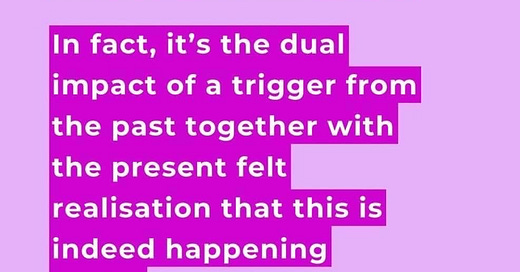Understanding the Difference Between Triggers and Retraumatization — And Why It Matters
In trauma recovery, few distinctions are more crucial — yet often misunderstood — than the difference between a trigger and retraumatization.
“Retraumatisation is different from a trigger. In fact, it’s the dual impact of a trigger from the past together with the present felt realisation that this is indeed happening again.”
This single sentence illuminates a profound truth about the nervous system: the body doesn’t just remember trauma; it relives it when conditions appear to repeat.
A Trigger Is a Spark — Retraumatization Is the Fire
A trigger is any sensory cue — a smell, sound, image, phrase, or situation — that reminds someone of a past traumatic event. It ignites the emotional and somatic echoes of that trauma. However, with grounding techniques and support, a person can often move through a trigger. It’s a wave that can be ridden.
Retraumatization, however, is deeper. It occurs when the nervous system perceives that not only is the past being remembered — it is repeating. The threat isn’t over. The danger is here. It is the moment when the mind and body scream, “It’s happening again.”
For example, a domestic violence survivor might be triggered by a slamming door, but retraumatized if their new partner slams the door and yells a phrase their abuser used. The experience is no longer a distant echo — it becomes the embodiment of reliving the very terror they once escaped. Their entire system collapses under the weight of déjà vu and betrayal of safety.
The Physiology of Retraumatization
Retraumatization is not just psychological — it is neurological. The amygdala, the brain’s alarm center, overrides the rational prefrontal cortex. Cortisol and adrenaline flood the body. In trauma, the body stores the memory not as a story but as a state: a tight chest, racing heart, shallow breath, frozen limbs. When retriggered and re-exposed to a similar dynamic, those physiological states reactivate in full.
The nervous system doesn’t know this is a “similar” event. It concludes: “This is the same.” Time collapses. Safety vanishes.
This is why retraumatization is often more dangerous than the original trauma — it creates layered wounding. The brain begins to internalize not just the trauma but the belief: There is no way out. I cannot trust safety. It will happen again. Without intervention, this pattern can entrench PTSD, dissociation, depression, or even suicidal ideation.
Systemic Retraumatization
This principle is most devastating in systems meant to protect victims — like the legal, educational, or healthcare systems — when they instead replicate the dynamics of their original abuse.
• When a survivor of domestic abuse is gaslit by a judge or therapist who refuses to believe their story…
• When a child is forced into visitation with a parent they’ve disclosed abuse against…
• When a parent loses custody for reporting danger to their children…
…these are not just triggers. They are systemic retraumatization.
It is not the memory of trauma — it is the living, breathing continuation of it. The body responds accordingly, shutting down, going numb, or reacting with what appears to be disproportionate emotion — but in truth is the body reliving an existential crisis.
Healing Requires More Than Managing Triggers
To truly support survivors, advocates, therapists, and institutions must understand and prevent retraumatization — not just help individuals cope with triggers.
This means:
• Creating safety: Emotional, physical, psychological, legal.
• Offering validation: Acknowledging their reality, especially when others denied it.
• Ensuring agency: Rebuilding the sense of choice and autonomy that trauma stole.
• Avoiding replication: Not using silencing, coercion, gaslighting, or control in “treatment” or intervention.
It also requires educating bystanders and professionals alike: Retraumatization is not an overreaction. It is a sign that we — society, institutions, and systems — have failed to protect the wounded from being wounded again.
Triggers are difficult. But retraumatization is devastating. It breaks open a wound that never fully closed, and reinforces the belief that healing isn’t possible. For victims, understanding the difference brings clarity to their pain. For practitioners, it offers a map toward trauma-informed support. And for systems, it presents a challenge: to finally stop blaming survivors for their symptoms and start dismantling the conditions that created — and recreated — their suffering.
Retraumatization doesn’t just reopen the past — it re-roots it in the present. If we want healing to take root, we must stop watering the same weeds.




